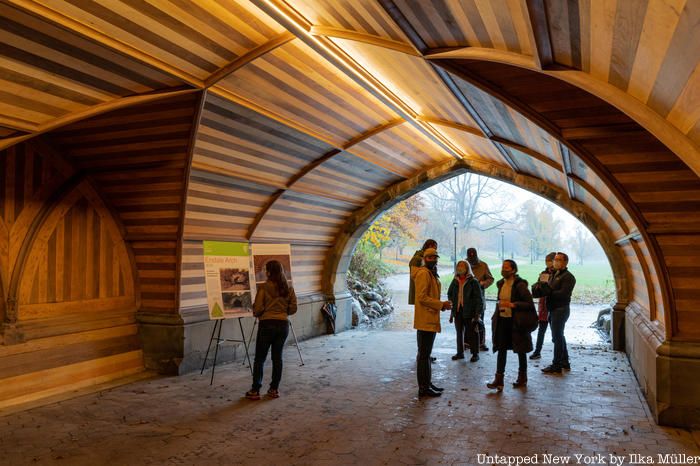Last Chance to Catch NYC's Holiday Notalgia Train
We met the voices of the NYC subway on our nostalgia ride this weekend!


Visitors to Brooklyn’s Prospect Park can now see striking original details of one of the park’s oldest structures, Endale Arch. The arch was one of the first architectural features erected in the park in the 1860s. Now, after a $500,000 five-year restoration, original features of Olmsted and Vaux’s design are revealed for the first time in over a century.

Endale Arch circa 1890, Prospect Park Alliance Archives, Bob Levine Collection
Endale Arch serves as the majestic entryway to Prospect Park’s Long Meadow from Grand Army Plaza. Park designers Frederick Law Olmsted and Calvert Vaux wanted the arch to blend into the landscape and transport visitors from the urban bustle of Brooklyn to the natural tranquility of the park. The designers created a picturesque design to solve the practical problem of separating pedestrian traffic from the horse, carriage, and bicycle traffic on Park Drive above.
Pieces of New Jersey brownstone and yellow Berea stone created a polychromatic masonry pattern on the arch’s exterior. Inside, the tunnel was paneled with alternating rows of white pine and black walnut wood. Benches were tucked into vaulted niches, offering parkgoers a cozy place to rest. In a New York Times article from 1868, the reporter notes that “In entering bridges as ordinarily constructed, one would suppose himself in a cellar or vault,” but Endale has “rather the appearance of a pleasant room, and will be a comfortable shelter in case of a sudden shower.” Unfortunately, weather and wear took its toll on the arch. Over the decades, interior details were painted over with green anti-graffiti paint, and water damage caused many of the original wood panels to rot away.

Photograph by Paul Martinka, Courtesy of Prospect Park Alliance
Initial restoration work on the arch began in 2015. The Prospect Park Alliance stabilized stone retaining walls and the surrounding hillsides, removed invasive plants, and added an array of native plantings. Improvements were made to the arch and pathway to address drainage issues and reduce potential flooding and water damage.

For the final phase of the restoration, the Alliance worked with Barnhart Restoration to bring the arch back to its original splendor. As layers of paint and grit were stripped away, original details were revealed. While much of the original woodwork had deteriorated, panels inside the sitting niches were in good enough condition to remain intact. New wood will cover the rest of the interior. The restoration team decided to leave one cross vault exposed to showcase the brick and granite structure. Patterned brickwork accentuates the curve of the vault and shows the exquisite craftsmanship of the arch’s construction.

The historic benches, which are believed to have been removed in the 1930s, have not yet been replaced. In addition to the restoration of original features, a new 21st-century feature has been installed. LED lighting now runs along the center of the arch to illuminate the tunnel and its stunning design.
This extensive restoration was funded by the Tiger Baron Foundation, with additional support from Council Member Brad Lander through District 39 participatory budgeting. The restoration of Endale Arch is part of a larger effort by Prospect Park Alliance to improve the northeast corner of the park. Future work includes adding two new entrances along Flatbush Avenue and improving pathways and lighting in the Vale. Ongoing restorations continue in this historic park so future New Yorkers can enjoy its treasures as much as New Yorkers of the past 150 years.

Next, check out The Top 12 Secrets of Brooklyn’s Prospect Park and see inside the Soldiers’ and Sailors’ Memorial Arch, the next landmark to be restored at Prospect Park.
Subscribe to our newsletter